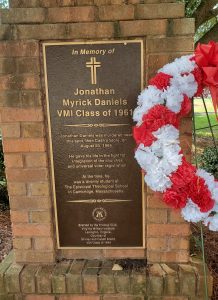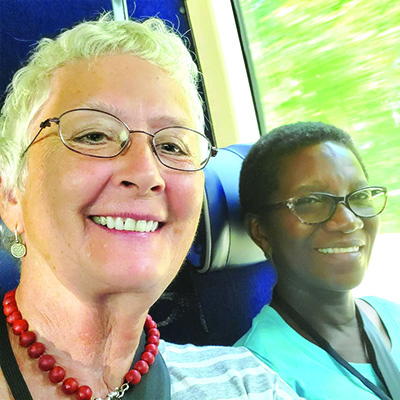By Pamela Barefoot
Special to the Eastern Shore Post
In 2019, I learned of an escorted bus tour called “Journey to Montgomery” out of Durham, N.C.
Nearly 60 of us from all walks of life would travel by bus to Montgomery and Selma, Ala., in the heat of August, visiting civil rights memorials, museums, and the Selma to Montgomery National Historic Trail.
I told my friend Doug Tanner, a former Methodist minister on the Eastern Shore and founder of the Faith & Politics Institute in Washington, D.C., about the trip. He encouraged me to go, having experienced several similar pilgrimages to Alabama with Civil Rights icon John Lewis and his congressional colleagues. Doug had written about his own experience in a published essay, “The Truth Can Set Us Free: Toward a Politics of Grace and Healing.”
My traveling companion and hotel roommate was Carol Mapp, an African American woman who is married to an Onancock native. We shared the far rear seats of the bus together going and coming, along with perspectives of our experience.
Our bus left Durham very early, and along the way, we watched civil rights documentaries including the PBS special “Freedom Riders” and “I Am Not Your Negro,” as well as the movie “Selma.” We listened to poetry, hymns, and performances by three prominent African Americans who live in North Carolina: Poet Laureate Jaki Shelton Green, jazz/gospel vocalist Jennifer Evans, and noted playwright Mike Wiley, who specializes in documentary theater about civil rights struggles. We joined together singing freedom songs, including “Hallelujah, I’m A-Traveling” and “We Shall Overcome.” One-third of our participants were African American, and we shared our mutual but varied reactions and experiences throughout the journey.
We arrived in Montgomery after our day-long bus journey. Our few days there were filled with deeply emotional experiences, including visits to the Rosa Parks Museum, as well as the Freedom Rides Museum, housed in the original Greyhound terminal made famous by the events of 1961. We attended a performance of Mike Wiley’s “Breach of Peace: A Commemoration of the Freedom Riders.” We traveled to the Lowndes Interpretive Center on the Selma to Montgomery National Historic Trail with exhibits highlighting the 54-mile march from Selma to Montgomery that culminated in the 1965 Voting Rights Act.
Then the bus transported us to the Lowndes County Courthouse, where we participated in the annual Jonathan Daniels Pilgrimage. Daniels was the 1961 valedictorian of Virginia Military Institute who went on to graduate school at Harvard. In 1965, while studying at the Episcopal Divinity School in Cambridge, Mass., he heard the calling of Dr. Martin Luther King Jr. to go to Selma to help secure voting rights for all citizens. He was arrested during a peaceful voter rights demonstration, and after several days in jail in Hayneville, Ala., he was killed instantly outside a small store while shielding a young African American girl from a part-time deputy’s shotgun.
Jonathan Daniels was a VMI classmate of my friend, Eastern Shore resident Ashby Taylor, of Craddockville. While walking and singing hymns in the commemoration for Daniels and other local civil rights martyrs, I called Ashby to let him know where I was. He was astounded. He told me that Jonathan Daniels was a saint, a true role model, and everyone loved him.

There were several classmates from VMI in attendance at this event, and a monument to Daniels stands on the courthouse grounds in Hayneville. A plaque in the VMI Barracks honors him with a quote from his valedictory speech: “I wish you the decency and nobility of which you are capable.” And in the Jonathan Daniels’ Courtyard at VMI, a plaque features a quote from Dr. Martin Luther King Jr.: “One of the most heroic Christian deeds of which I have heard in my entire ministry was performed by Jonathan Daniels.”
After the pilgrimage, we listened to an author who spoke about her father’s lynching. The bus dropped us off in historic Selma, where we took our time walking across the Edmund Pettus Bridge, site of the Bloody Sunday events of 1965. That first peaceful walk for voting rights ended with state troopers and vigilantes attacking the nonviolent participants; young John Lewis, a hero of the civil rights movement before he became a congressman, suffered a skull fracture. Martin Luther King Jr. arrived for the second peaceful walk, along with hundreds of other Americans both black and white showing their support. At the foot of the Edmund Pettus Bridge is the National Voting Rights Museum, where we were met by our bus.
Our final day was filled with even more deeply moving experiences, including a visit to the new National Memorial for Peace and Justice. Walking along in silence, I was haunted by the enormous steel slabs engraved with the names of more than 4,400 black victims of lynching in more than 20 states between 1877 and 1950. I walked beneath these towering structures, searching for anything related to the Eastern Shore of Virginia. I found nothing from Northampton County but did locate a memorial to a lynching in Accomack County.


Outside on the ground laid a duplicate monument, waiting to be claimed by Accomack County.
From there we went back to downtown Montgomery for our final stop, the Legacy Museum, which features exhibits and interactive displays dedicated to the history of slavery and racism in the United States.
I can’t speak highly enough about what an eye-opening experience this was, and if anyone is interested in American history, you can’t miss it. A future Journey to Montgomery with actor-playwright Mike Wiley is scheduled for August 19-23. Read more about it and sign up at https://highergroundjourneytoalabama-2020.eventbrite.com (email: [email protected]). An alternative is the Living Legacy tours: http://www.uulivinglegacy.org/living-legacy-pilgrimage.html (email: [email protected]).



